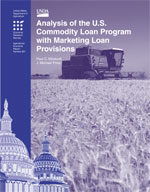Analysis of the U.S. Commodity Loan Program with Marketing Loan Provisions
- by Paul Westcott and Michael Price
- 4/2/2001
Overview
Over the next several years, crop prices are projected to be below to slightly above commodity loan rates. As a result, marketing loan benefits to farmers, in the form of loan deficiency payments and marketing loan gains from the commodity loan program, are likely to continue to be sizeable. The level of realized per-unit revenues facilitated by marketing loans exceeds commodity loan rates, thereby raising expected net returns to farmers. Model simulations show that the loan program can raise total acreage planted to major field crops, generally increasing levels of domestic use and exports while lowering crop prices. Cross-commodity effects of supply response to relative returns (including marketing loan benefits), however, result in acreage shifts among competing crops, which can lead to reductions in plantings of some crops in some years. Most impacts occur in the years when there are marketing loan benefits, with little effect in subsequent years when prices rise high enough to eliminate marketing loan benefits. The livestock sector benefits from these outcomes because of generally lower feed costs.
Download
-
Entire report
Download PDF -
Abstract
Download PDF -
Contents
Download PDF -
Summary
Download PDF -
Introduction
Download PDF -
Commodity Loan Programs--Price Supports and Marketing Loans
Download PDF -
Marketing Loans and Realized Per-Unit Revenues
Download PDF -
Analytical Framework
Download PDF -
Modeling Framework and Implementation
Download PDF -
Simulation Results
Download PDF -
Conclusions
Download PDF -
References
Download PDF

